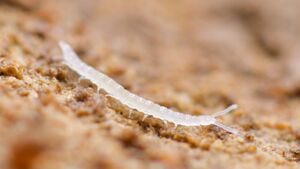Symphyla: Difference between revisions
No edit summary |
|||
| Line 22: | Line 22: | ||
== Life Cycle == | == Life Cycle and Habitat== | ||
Symphylan eggs can be found in any season, but typically the most eggs are found in the fall and early spring when weather is cooler [3]. Increasing egg numbers can also be found in April to August in the upper layers of the soil [4]. Eggs are white with ridges when first laid, and turn a light tan color throughout their cycle [4], and can be produced in groups anywhere between 4 and 25. These eggs typically hatch in about 40 days [3], producing young symphylans or nymphs. This means that nymphs and adults are active in late fall to winter and the spring [4]. Nymphs have less trunk segments compared to adults, and only have 6 pairs of legs as opposed to 12. While life cycle and span depend on different conditions, such as soil temperatures, soil moistures, and soil structure, it typically takes around 4 months for a nymph to progress into an adult in moderate conditions, meaning the full egg to adult process takes about 5 months [4]. | |||
Revision as of 23:39, 9 May 2022
Taxonomy
| Kingdom | Phylum | Subphylum | Class | |
|---|---|---|---|---|
| Classification | Animalia | Arthropoda | Myriapoda | Symphyla |


Description
Symphylans are small pseudocentipedes in the phylum Arthropoda and the subphylum Myriapoda. Though they resemble centipedes, they are much smaller ranging in size from 2 to 30 millimeters, and are translucent in color [1]. Colored symphyla only occur when they absorb color from food, usually yellow or red [2]. Symphyla have two body regions, a head and a segmented trunk, containing 12 segments with one pair of legs in each on the trunk which allow them to move rapidly throughout the soil, and segmented antennae on the head [1]. Each leg has a stiff spine at the base, promoting movement, and a small sac, which allows for fluid exchange and regulation in the creature [2]. Younger symphylans only have 6 pairs of legs, but these increase to 12 throughout their lifetimes [1]. Symphylans also have a postantennal organ on their head region, similar to collembola, and 3 mouth parts [1]. There are two families of symphylans, being the Scutigerellidae and the Scolopendrellidae, which can only be easily differentiated by the rounded head of the Scutigerellidae opposed to the flatter of the Scolopendrellidae [2]. Both families lack eyes, and are blind [1].
Life Cycle and Habitat
Symphylan eggs can be found in any season, but typically the most eggs are found in the fall and early spring when weather is cooler [3]. Increasing egg numbers can also be found in April to August in the upper layers of the soil [4]. Eggs are white with ridges when first laid, and turn a light tan color throughout their cycle [4], and can be produced in groups anywhere between 4 and 25. These eggs typically hatch in about 40 days [3], producing young symphylans or nymphs. This means that nymphs and adults are active in late fall to winter and the spring [4]. Nymphs have less trunk segments compared to adults, and only have 6 pairs of legs as opposed to 12. While life cycle and span depend on different conditions, such as soil temperatures, soil moistures, and soil structure, it typically takes around 4 months for a nymph to progress into an adult in moderate conditions, meaning the full egg to adult process takes about 5 months [4].